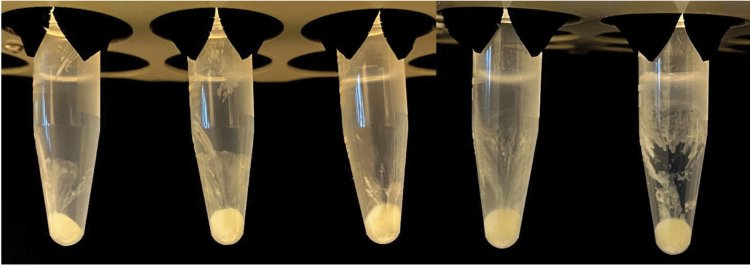博文
科学家解开了一个世纪的化学谜题
 精选
精选
||
科学家解开了一个世纪的化学谜题
诸平

Fig. 1 Credit: Journal of Colloid and Interface Science (2024). DOI: 10.1016/j.jcis.2024.06.062

Fig. 2 Phase separation: the formation of a polymer-rich phase and a supernatant phase
据荷兰特文特大学(University of Twente简称UT, 7500 AE Enschede, the Netherlands)网站2024年6月17日报道,该校科学家解开了一个世纪的化学谜题(Scientists solve century-old chemistry riddle)。
当两种带相反电荷的聚合物(聚电解质)溶液混合时,会发生相分离,导致富聚合物相和上清相的形成。所有成分,即聚电解质和反离子的精确分布尚未确定。特文特大学的研究人员现在可以使用核磁共振(NMR)光谱定量准确地测量这些成分的分布位置。相关研究结果于2024年6月7日已经在《胶体与界面科学学报》(Journal of Colloid and Interface Science)在线发表——Giulia Allegri, Jurriaan Huskens, Ricardo P Martinho, Saskia Lindhoud. Distribution of polyelectrolytes and counterions upon polyelectrolyte complexation. Journal of Colloid and Interface Science, 2024, 672: 654-663. DOI: 10.1016/j.jcis.2024.06.062. Pub Date: June 7, 2024.
90多年来,化学家们一直对两种带相反电荷的聚合物溶液混合后形成的聚电解质复合物着迷。更好地了解这些配合物对于开发基于这些配合物的材料至关重要。这些材料包括用于水过滤的多孔膜,用作离子交换膜的盐塑料(saloplastics),以及水基萃取介质。
新方法(New method)
为了提高这些材料的适用性,科学家们开发了一种方法来更好地理解这些复合物。该论文的第一作者、特文特大学(UT)博士生Giulia Allegri解释说:“我们引入了一种基于核磁共振波谱的新方法。它使我们能够充分量化系统的组成,并测量所有组分在络合发生后的分布情况。”这项研究标志着第一次在两相中对所有成分进行了定量测定。
相分离:形成富聚合物相和上清相(Phase separation: the formation of a polymer-rich phase and a supernatant phase)
此外,核磁共振光谱学带来了更多的优势,“我们开发的科学实验计划非常快;我们可以在不到40分钟的时间内完成完整的分析,”合著者Ricardo Martinho说。Giulia Allegri补充说,这种方法是无标签和非侵入性的。她说:“聚合电解质复合物(Polyelectrolyte complexes)在自然界中很常见。我们设想我们的方法将有助于更好地理解天然聚合电解质复合物,并有助于改进聚合电解质复合物材料。”
更多信息(More information)
Giulia Allegri是荷兰特温特大学(UT)科学技术学院分子与材料系分子纳米制造研究小组(Molecular Nanofabrication Group, Department for Molecules & Materials, MESA+ Institute & Faculty of Science Technology, University of Twente, 7500 AE Enschede, the Netherlands)的博士生,由Saskia Lindhoud博士指导。Ricardo Martinho博士是荷兰特温特大学(UT)科学技术学院分子与材料系生物分子纳米技术研究小组(Biomolecular Nanotechnology Group, Department for Molecules & Materials, MESA+ Institute & Faculty of Science Technology, University of Twente, 7500 AE Enschede, the Netherlands)的研究员。他们与Jurriaan Huskens教授均系上述研究论文的合著者。
上述介绍,仅供参考。欲了解更多信息,敬请注意浏览原文或者相关报道。
Hypothesis: Understanding polyelectrolyte complexation remains limited due to the absence of a systematic methodology for analyzing the distribution of components between the polyelectrolyte complex (PEC) and the dilute phases.
Experiments: We developed a methodology based on NMR to quantify all components of solid-like PECs and their supernatant phases formed by mixing different ratios of poly(allylamine hydrochloride) (PAH) and poly(acrylic acid)-sodium salt (PAA). This approach allowed for determining relative and absolute concentrations of polyelectrolytes in both phases by 1H NMR studies. Using 23Na and 35Cl NMR spectroscopy we measured the concentration of counterions in both phases.
Findings: Regardless of the mixing ratio of the polyelectrolytes the PEC is charge-stoichiometric, and any excess polyelectrolytes to achieve charge stoichiometry remains in the supernatant phase. The majority of counterions were found in the supernatant phase, confirming counterion release being a major thermodynamic driving force for PEC formation. The counterion concentrations in the PEC phase were approximately twice as high as in the supernatant phase. The complete mass balance of PEC formation could be determined and translated into a molecular picture. It appears that PAH is fully charged, while PAA is more protonated, so less charged, and some 10% extrinsic PAH-Cl- pairs are present in the complex.
https://blog.sciencenet.cn/blog-212210-1439039.html
上一篇:以前未知的免疫系统联系发现可能导致新的癌症治疗
下一篇:新陈代谢不健康与大脑健康状况恶化有关